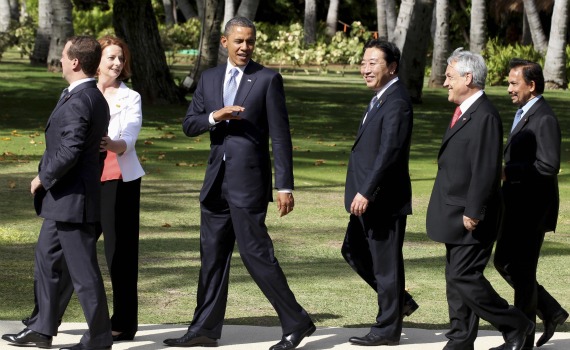Obama to Asia: It’s Our Party
More on:

President Obama is having a good week. He held court in Hawaii at the Asia Pacific Economic Cooperation forum, pushed through a reduction on tariffs for environmental goods, and gained steam on what has become his signature regional free trade agreement, the Trans-Pacific Partnership (TPP), with interest from Japan, Canada, and Mexico. On to Australia, President Obama and Prime Minister Gillard agreed to enhance joint military training and provide the United States with access to Australian bases. Score two for the president. His last stop will be Bali for the East Asian Summit. For a home run, the president need only let Washington’s allies take the lead in setting the agenda—thereby allaying quietly-voiced concerns among some of the smaller Asian nations that the United States would try to control the agenda—and reaffirm the willingness of the United States to support its partners’ interests.
For many observers, President Obama’s trip represents a “return to Asia.” The truth is that the United States never left Asia; it was just focused elsewhere in the region. Mostly, Washington was busy banging its head against the wall trying to find ways to work constructively with China (translation: get the Chinese to change their economic, political, and security policies) and to persuade North Korea to step back from the nuclear brink. Suffice it to say that neither effort yielded a significant return. The president and his team have now realized that it is much more substantively productive and politically profitable to spend time with people whose overall political values, economic practices, and strategic interests are generally aligned with those of the United States—namely all the important players in the region except for China.
Beijing’s reaction to President Obama’s initiatives in the region, unsurprisingly, has been one of deep unhappiness. In conversations I had with Chinese officials last week in Beijing, it was clear that they believed the United States was 1) done with the Middle East and now turning its focus to the Asia Pacific in an effort to contain China, 2) stirring up trouble for China among otherwise friendly countries in the region, and 3) developing the “mysterious” TPP as an anti-China economic strategy. There was no official recognition that at the outset it was China’s assertive behavior that created the circumstances in which the United States could play such an enhanced role in the region. Forgotten or ignored were Foreign Minister Yang Jiechi’s comments at the 2010 ASEAN Regional Forum that “China is a big country and other countries are small countries, and that’s just a fact”; the continued sparring between Chinese vessels and those of its neighbors in the East and South China Sea; and the general unattractive nationalist rhetoric of Beijing’s official newspapers warning that if countries in Asia “don’t want to change their ways” they will need to “prepare for the sound of cannons.”
In some respects, Washington has done little more than to take advantage of Beijing’s missteps. “Where to from here?” is the tougher question. Washington’s vision of the 21st century Asia Pacific appears to marry U.S. leadership with Pacific partnership. China is consigned to the role of the outsider peering in, unless it starts to play by the norms that the rest of the region has established. But China’s economic and military throw-weight is growing and, along with it, its capacity to write its own rules of the game. For the United States to play a long-term leadership role in the region, it needs to get its economic house in order both to maintain a serious military presence and to help drive regional economic growth. Only then can Washington ensure that its Asia Pacific vision is not only reassuring but also realistic.
More on:
 Online Store
Online Store
